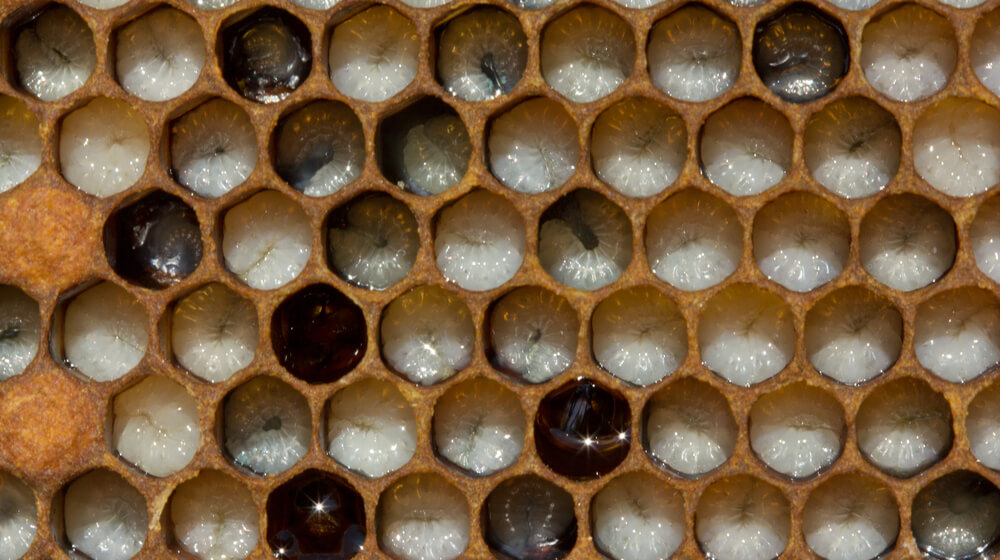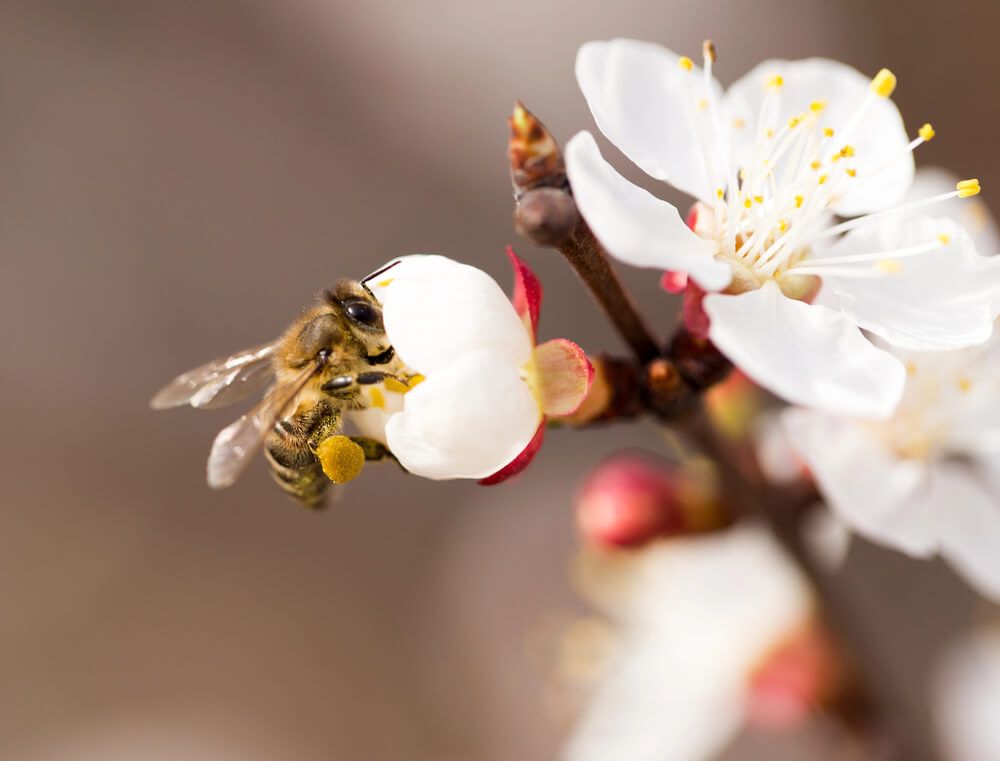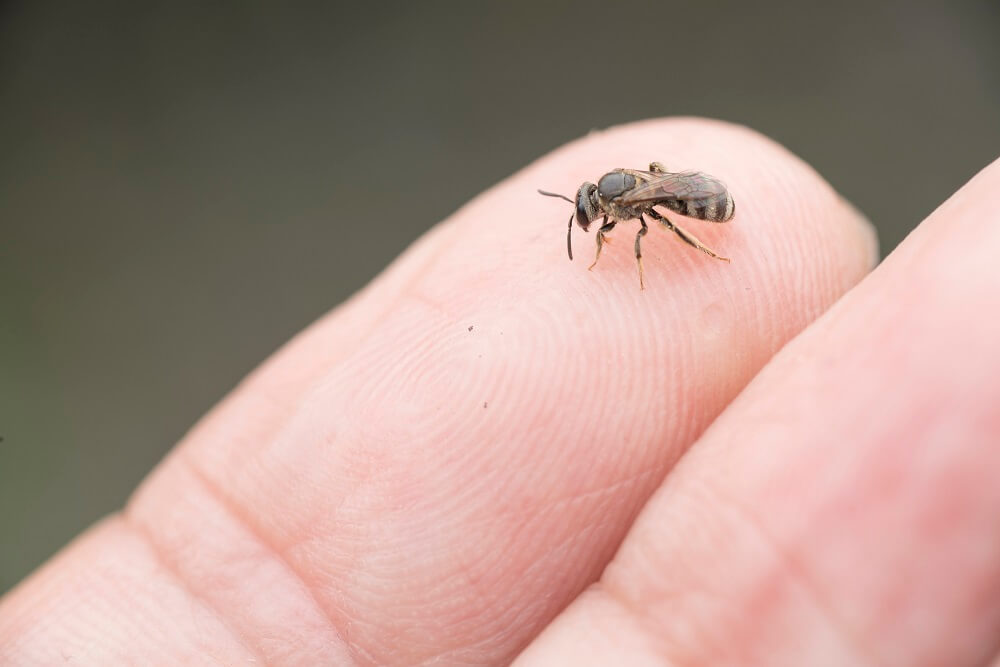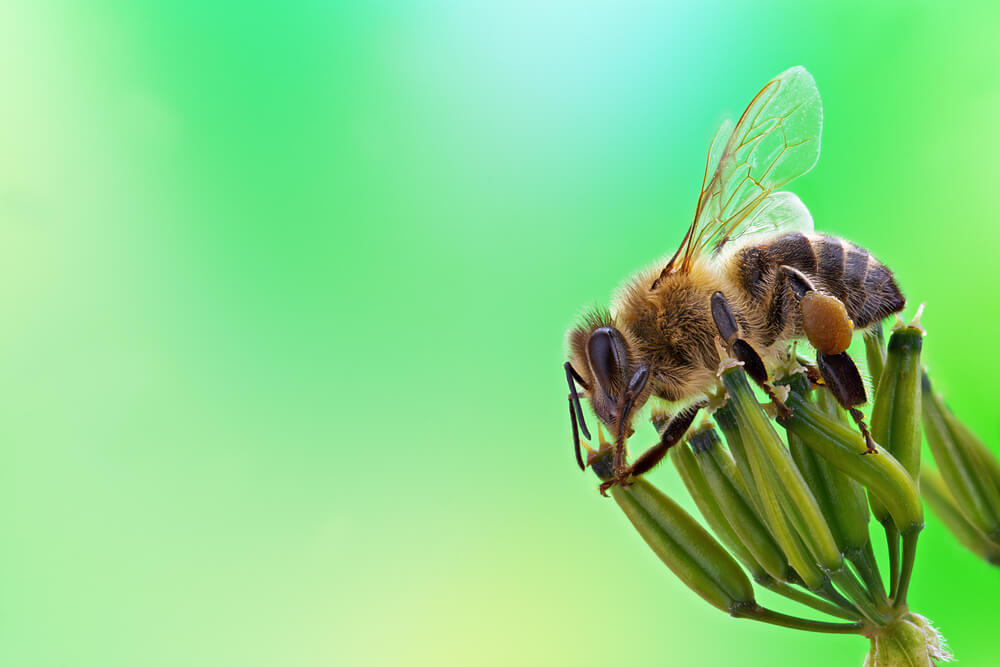What Are Bee Larvae?
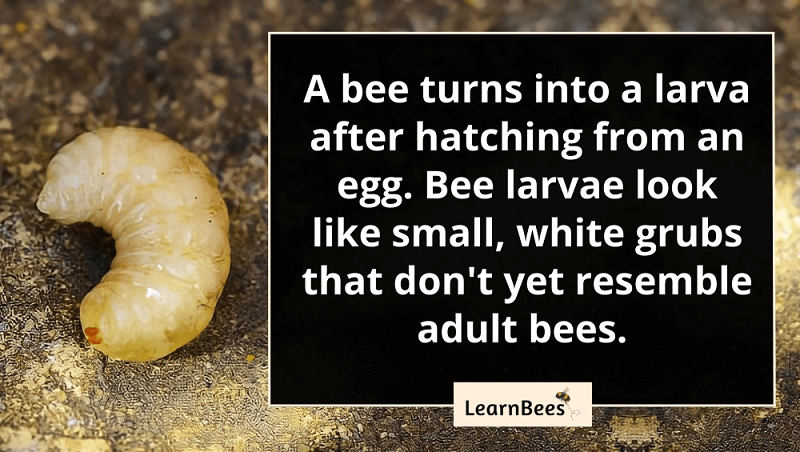
A bee becomes a larva (plural: larvae) in its second development stage.
Bees pass through four stages:
- Egg
- Larva
- Pupa
- Adult
Humans also go through various developmental changes.
Humans pass from baby to toddler to teenager to adult. Meanwhile, bees pass from egg to larva to pupa to adult.
Bees begin with the egg stage, which look like white grains of rice under a microscope. Bee eggs are tiny and can be hard to see with the naked eye.
After a few days, the egg hatches and the larva is formed.
A bee larva’s job is to eat continuously so it can develop. As the larva eats and grows, it periodically sheds its outer skin. This shedding process is known as “molting,” and it allows the larva to grow larger each time.
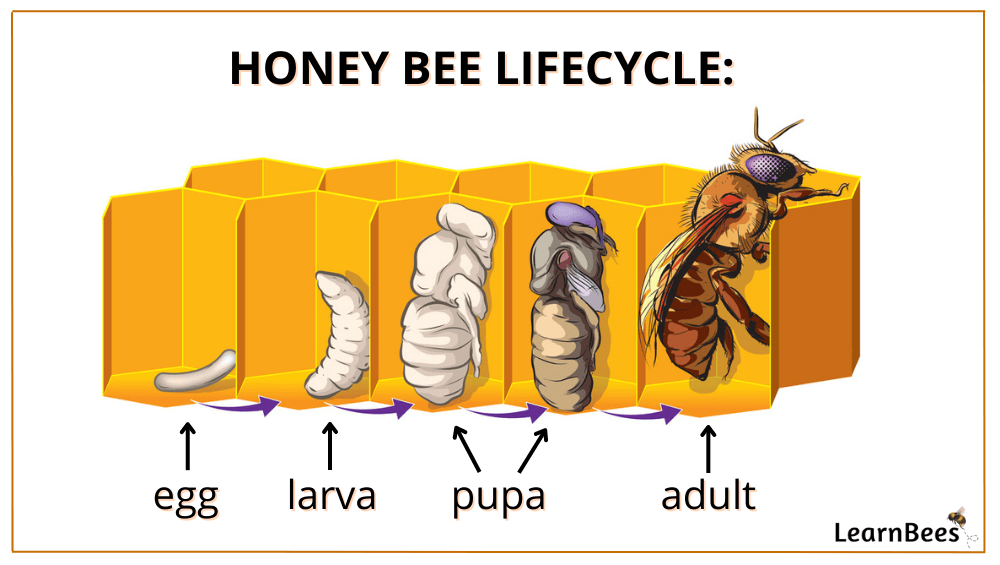
And here’s a fact that might surprise you:
Many bees even spin cocoons like moths do.
Cocoons are silky webs that some insects spin around themselves for protection. Think of a cocoon as a silk ‘sleeping bag’ bees make before they pupate.
And remember:
The adult bee looks entirely different from the grub-like larva that it once was. This transformation is called metamorphosis, which is the scientific way of saying “really big change.”
Interestingly enough?
Different bee species take different amounts of time to develop.
For example, some bees only take a few weeks to emerge as adults. Other bees can take years.
Bees that take years to develop are commonly found in desert climates with scarce rainfall and flowers. Half the bees will emerge, and the other half will remain in their nest. This way, only half the bees die if there aren’t enough flowers.
What Do Bee Larvae Eat?
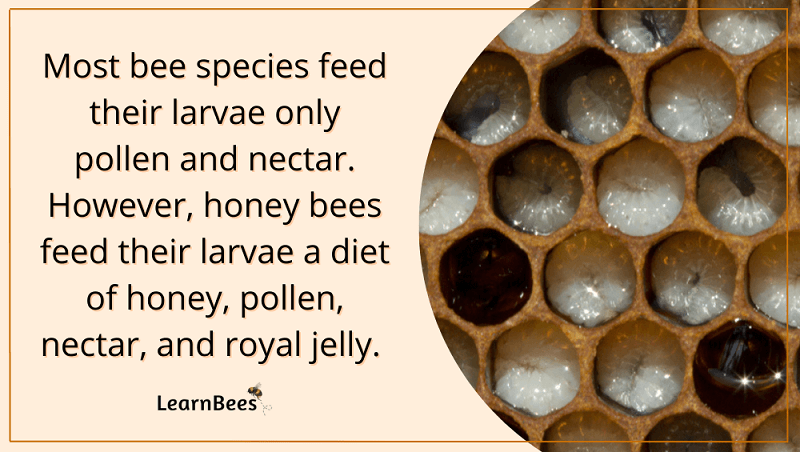
Most bee larvae eat pollen and nectar their mother has stored in the nest for them.
Now you might be asking…
How does a larva eat if it’s only a white grub with no body parts?
Good question.
While bee larvae don’t have distinct legs or eyes, they do have large mouths used for eating. They also have tiny leg nubbins used for moving food around.
That said, there are variations in larva diet amongst bee species.
Remember:
There are more than 20,000 bee species worldwide. Common examples include honey bees, bumble bees, carpenter bees, and mason bees.
Most bee species are solitary creatures that live alone.
In fact, most solitary bees never even meet their mothers. Bees tend to have short lifespans and die soon after nesting.
This means that once the adult bees emerge from the nest, the mother is usually long gone. As a result, the mother bee has to leave enough food behind for the bee larvae to eat.
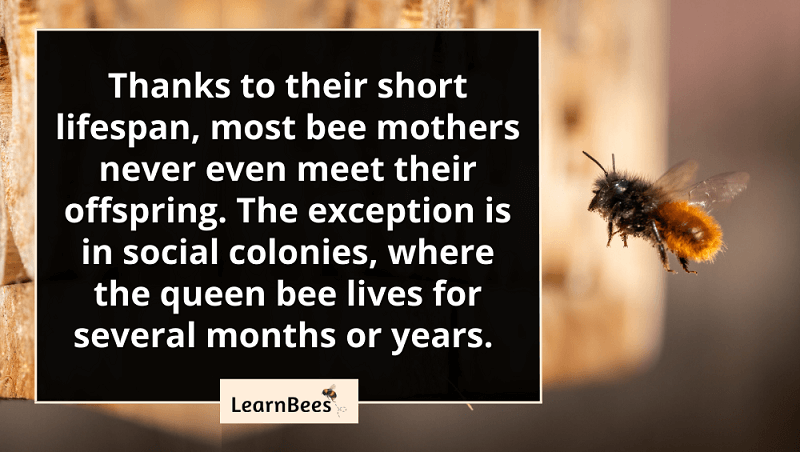
But there are exceptions to this.
For example, honey bees and bumble bees are two types of bees that live in social colonies.
Both bumble bee and honey bee queens live to meet their offspring. Additionally, queen bees have the help of worker bees. Worker bees are responsible for feeding and tending to the bee larvae.
But unlike other types of bees?
Honey bee larvae eat more than just pollen and nectar.
They also eat honey and royal jelly, depending on the type of honey bee they are.
For instance, queen honey bees exclusively eat royal jelly when they’re in the larvae stage.
Royal jelly is a milky substance rich in protein, carbs, amino acids, fatty acids, vitamins, and minerals. It’s thought that this special “royal jelly” diet is what allows larvae to develop into queen honey bees.(1)
Meanwhile:
Worker honey bees eat a combination of royal jelly, pollen, nectar, and honey while they’re developing into adult bees.
Where Do Bee Larvae Live?
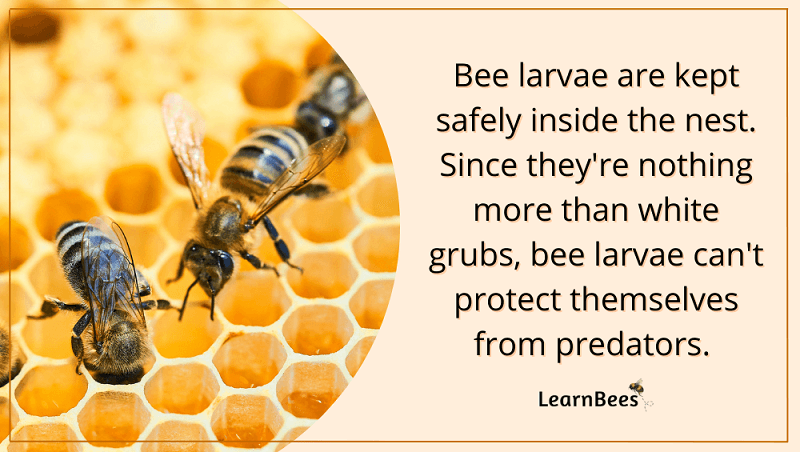
Bee larvae live inside their nest.
As such, most people never see bees in their larval stage because they’re not out in the open. Instead, they’re safely tucked away inside their nest, where they can focus on eating and growing.
With that in mind, bee larvae can live in various nesting spots depending on the type of bee.
For example:
Honey bees make their nests out of beeswax. Honey bees form the beeswax into hexagonal cells that hang from places like tree branches.
In contrast, bumble bees tend to make their nest in abandoned rodent burrows in the ground. Queen bumble bees build waxen pots filled with nectar and pollen to house her bee larvae.
And lastly:
Carpenter bees build their nests in wood. The female carpenter bees use their strong mandibles (jaws) to drill holes that can be half an inch wide. From there, she lays her eggs in the tunnels.
So as you can tell, bee larvae live in various places, depending on the species.
No matter where they live, the larva’s environment is generally as safe and protected as possible.
FAQs on Bee Larvae
- Are bee larvae maggots?
- Can you eat bee larvae raw?
- What are the benefits of eating bee larvae?
- Do larvae turn into bees?
- How long does it take for bee larvae to hatch?
- What does a bee larva look like?
- Is bee larvae in honey?
- How long does a bee stay a larva?
- What are bee larvae called?
- Where do bees lay their larvae?
- Do wasps eat bee larvae?
- Can bees make a queen from larvae?
- How do you identify queen bee larvae?
- Why are my bees carrying larvae out of the hive?
- Can you eat larvae in a honeycomb?
- How many larvae do bees lay?
- What color is a bee larva?
- What do bumble bee larvae look like?
- How big is a bee larva?
Are bee larvae maggots?
People often ask, “What is the difference between maggots and larvae?”
Bee larvae are not maggots.
Maggots are fly larvae, which are the immature stages of various species of flies. Bee larvae, on the other hand, are the immature stages of different bee species.
Bees and flies are two different insects that play differing roles in the ecosystem.
—> Go back to the FAQs on bee larvae
More to Explore:
Can you eat bee larvae raw?
Bee larvae are considered a delicacy in some countries. It’s said to have a nutty taste and crunchy texture when dried.
—> Go back to the FAQs on bee larvae
More to Explore:
What are the benefits of eating bee larvae?
There is limited data concerning the nutrient composition of bee larvae.
However, bee larvae are said to be high in protein, fats, and carbohydrates. It’s also thought to be a good source of phosphorus, magnesium, and potassium.(2)
With that in mind, it’s more practical to get these nutrients from other foods instead of bee larvae.
—> Go back to the FAQs on bee larvae
More to Explore:
Do larvae turn into bees?
Yes, larvae eventually turn into adult bees after the pupa stage.
—> Go back to the FAQs on bee larvae
More to Explore:
How long does it take for bee larvae to hatch?
“How do bee larvae turn into bees?” is a common question.
A bee can take a few weeks to a few years to emerge as an adult. This depends on the bee species and the climate it’s raised in.
For example, some bees that live in desert climates can take years to emerge due to a lack of rainfall and flowers in that area.
Honey bees can take anywhere from 15-24 days, depending on the type of honey bee. Queen honey bees take the shortest development time, while drones take the longest.
—> Go back to the FAQs on bee larvae
More to Explore:
What does a bee larva look like?
Bee larvae look like small, white worms. They can range in size depending on the species of bee. Many people refer to bee larvae as having the appearance of “grubs” because they have no wings, legs, or eyes. They’re also white or off-white in color.
—> Go back to the FAQs on bee larvae
More to Explore:
Is bee larvae in honey?
In most cases, honey doesn’t contain bee larvae.
Honey bees have separate areas where they lay eggs and make honey. It’s not 100% foolproof, though, as sometimes honey and larvae may get mixed up a bit.
—> Go back to the FAQs on bee larvae
More to Explore:
How long does a bee stay a larva?
It depends on the bee species.
For instance, worker honey bees have an average larval stage of six days, while queen honey bees have a larval stage of about five and a half days.
This can vary depending on the type of bee.
—> Go back to the FAQs on bee larvae
More to Explore:
- Ground Bees: Are They a Threat to Your Yard?
- Wasps vs. Honeybees: Are They Different?
- Do Bumble Bees Bite?
What are bee larvae called?
Bee larva is singular, while larvae is plural.
Beekeepers refer to larvae as “bee brood,” which is a collective term that includes the eggs, larvae, and pupae of honey bees.
—> Go back to the FAQs on bee larvae
More to Explore:
Where do bees lay their larvae?
For starters, bees don’t lay larvae. They lay eggs that later hatch as larvae. Larvae live inside the nest, where they can be protected from predators and natural elements such as wind, rain, or snow.
The nesting site depends on the type of bee.
For example, honey bees often build their nests in trees. They produce beeswax and shape it into hexagonal cells that dangle from tree branches. Bee larvae are housed inside these hexagonal cells.
Mason bees, on the other hand, build their nests inside wooden tunnels. They create mud barriers in between each egg they lay.
—> Go back to the FAQs on bee larvae
More to Explore:
- Do Carpenter Bees Pollinate?
- How Long Do Bumble Bees Live?
- Honeybees vs. Bumblebees: How Do They Compare?
Do wasps eat bee larvae?
Yes, wasps will often prey on bee larvae, especially if they can’t find other food sources. This is why beekeepers need to keep an eye on their hives.
—> Go back to the FAQs on bee larvae
More to Explore:
- Do Queen Bees Eat Honey?
- Are Worker Bees Male or Female?
- Queen Bee Versus Worker Bees – How Do They Compare?
Can bees make a queen from larvae?
Yes, honey bees create queen bees from larvae. They feed the larvae a special diet of royal jelly, which is a protein-rich substance secreted from the glands of worker bees.
The larvae fed royal jelly develop into queen bees, while other larvae become worker or drone bees. The queen bee is in a special chamber called a “queen cell” and remains there until she fully matures and emerges.
—> Go back to the FAQs on bee larvae
More to Explore:
How do you identify queen bee larvae?
Queen honey bees can be identified by the larger size of their cell. Queen cells tend to be about one inch long and peanut-shaped.
—> Go back to the FAQs on bee larvae
More to Explore:
Why are my bees carrying larvae out of the hive?
Honey bees are clean creatures that will remove diseased or pest-infested larvae from the hive. Larvae can also die off due to sudden temperature changes or other factors. Dead larvae will be expelled from the hive to maintain cleanliness.
Additionally, honey bees will also carry drone larvae out of the hive to minimize the drone population.
—> Go back to the FAQs on bee larvae
More to Explore:
- How to Repel Bees Without Killing Them
- What Are the Four Stages of the Bee Life Cycle?
- How Long Do Wasps Live?
Can you eat larvae in a honeycomb?
Larvae can be eaten inside the honeycomb, but it’s not common in most countries. There are a select few countries that consider bee larvae a delicacy.
—> Go back to the FAQs on bee larvae
More to Explore:
How many larvae do bees lay?
Bees lay eggs, not larvae. Eggs eventually hatch into larvae.
The amount of eggs a bee lays depends on the species. For instance, a healthy honey bee queen can lay up to 2,000 eggs per day. Meanwhile, a female carpenter bee may only lay up to 10 eggs in her lifetime.
—> Go back to the FAQs on bee larvae
More to Explore:
What color is a bee larva?
Bee larvae are white or off-white in color.
—> Go back to the FAQs on bee larvae
More to Explore:
What do bumble bee larvae look like?
Bumble bee larvae look like small, white grubs with no legs, wings, or eyes.
—> Go back to the FAQs on bee larvae
More to Explore:
How big is a bee larva?
The size of the bee larva depends on the species. That said, larvae go through periods of growth known as “molting,” where they can increase their weight by 1,500 times.
